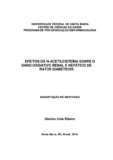| dc.creator | Ribeiro, Gianine Lima | |
| dc.date.accessioned | 2013-05-20 | |
| dc.date.available | 2013-05-20 | |
| dc.date.issued | 2010-10-22 | |
| dc.identifier.citation | RIBEIRO, Gianine Lima. Tissue oxidative stress of diabetic rats treated with N-acetylcysteine. 2010. 67 f. Dissertação (Mestrado em Farmácia) - Universidade Federal de Santa Maria, Santa Maria, 2010. | por |
| dc.identifier.uri | http://repositorio.ufsm.br/handle/1/8977 | |
| dc.description.abstract | Diabetes mellitus (DM) is a chronic disease characterized by hyperglycemia, which is related to oxidative stress and plays an important role in the development of other diseases and tissue damage, such as liver and kidney damage. Thus, it is important for studies with potential antioxidant that may reduce the deleterious effects of oxidative stress due to diabetes. In this sense, N-acetylcysteine (NAC) is used as a hepatoprotective drug in the treatment of acute poisoning by paracetamol to reduce oxidative damage. Along these lines, the aims of this study were to evaluate biomarkers of oxidative stress such as reduced glutathione (GSH), glutathione peroxidase (GPx), superoxide dismutase (SOD), malondialdehyde (MDA) and delta aminolevulinate acid dehydratase (ALA-D) in liver and kidneys of controls and animals with diabetes induced after treatment with NAC. Treatments consisted of intraperitoneal administration of 25 mg / kg and 75 mg / kg N-acetylcysteine. In the liver, MDA levels were significantly increased in the diabetic group compared to controls, treatment with 75 mg / kg reduced the levels of MDA, being similar to the control group. GSH levels of the enzyme was found to be highest in kidney and liver of diabetic animals than controls, and treatment with NAC led to these reduced levels in the liver of diabetic animals, but in the kidney, no changes. The levels of SOD and GPx decreased in the liver of diabetic animals compared to control, and administration of NAC did not alter these indices. Diabetes also reduced the activity of ALA-D in the liver, and treatment with 25 mg/ kg NAC did with this activity increased significantly. In the kidney, both doses of NAC increased the levels of ALA-D in diabetic animals. The results suggest that NAC may be more effective in the liver, the organ that suffers most oxidative changes, and especially in groups of diabetic animals. | eng |
| dc.format | application/pdf | por |
| dc.language | por | por |
| dc.publisher | Universidade Federal de Santa Maria | por |
| dc.rights | Acesso Aberto | por |
| dc.subject | Diabetes mellitus | por |
| dc.subject | Biomarcadores enzimáticos | por |
| dc.subject | Biomarcadores não enzimáticos | por |
| dc.subject | Estresse oxidativo | por |
| dc.subject | N-acetilcisteína | por |
| dc.subject | Diabetes mellitus | eng |
| dc.subject | Enzymatic biomarkers | eng |
| dc.subject | Non enzymatic biomarkers | eng |
| dc.subject | Oxidative stress | eng |
| dc.subject | N-acetylcysteine | eng |
| dc.title | Efeitos da N-acetilcisteína sobre o dano oxidativo renal e hepático de ratos diabéticos | por |
| dc.title.alternative | Tissue oxidative stress of diabetic rats treated with N-acetylcysteine | eng |
| dc.type | Dissertação | por |
| dc.description.resumo | O diabetes mellitus (DM) é uma doença crônica caracterizada pela hiperglicemia, que está relacionada Com o estresse oxidativo, o qual possui papel importante no desenvolvimento de outras patologias e danos teciduais, tais como dano hepático e renal. Dessa forma, faz-se importante à realização de estudos com possíveis antioxidantes, que possam diminuir os efeitos deletérios do estresse oxidativo decorrentes do diabetes. Neste sentido, a N-acetilcisteína (NAC) é um medicamento utilizado como hepatoprotetor por estimular a síntese de Glutationa Reduzida, diminuindo o dano oxidativo. Nesta linha, o objetivo deste trabalho foi avaliar o efeito antioxidante da NAC nos tecidos renal e hepático de ratos diabéticos através dos biomarcadores do estresse oxidativo como: glutationa reduzida (GSH), glutationa peroxidase (GPx), superóxido dismutase (SOD), malondialdeído (MDA) e ácido delta aminolevulinato desidratase (ALA-D) no fígado e rins de animais controles e com diabetes induzida, tratados e não tratados com NAC. Os tratamentos consistiram em administrações intraperitoneais de 25 mg/Kg e 75 mg/Kg de N-acetilcisteína. No fígado, os níveis de MDA foram significativamente aumentados no grupo diabético comparados ao grupo controle. O tratamento com 75 mg/Kg foi capaz de reduzir os níveis de MDA, ficando semelhantes ao grupo controle. Os níveis da GSH mostrou-se mais elevada no rim e no fígado dos animais diabéticos do que dos controles, e o tratamento com a NAC fez com que esses níveis fossem reduzidos no fígado dos animais diabéticos, entretanto no rim, não houve alterações. Os níveis de SOD e GPx diminuíram no fígado dos animais diabéticos quando comparados ao controle, e a administração de NAC não alterou esses índices. O diabetes também diminuiu a atividade da ALA-D no fígado, e o tratamento com a 25 mg/Kg NAC fez com essa atividade aumentasse significativamente. No tecido renal, ambas as doses de NAC elevaram os níveis de ALA-D nos animais diabéticos. Diante dos resultados encontrados, comparando-se os tecidos renal e hepático dos ratos controles com os diabéticos tratados com NAC, sugere-se que a NAC demonstrou diminuir o dano oxidativo mais no fígado do que no rim. | por |
| dc.contributor.advisor1 | Garcia, Solange Cristina | |
| dc.contributor.advisor1Lattes | http://lattes.cnpq.br/6687355709603379 | por |
| dc.contributor.referee1 | Beck, Ruy Carlos Ruver | |
| dc.contributor.referee1Lattes | http://lattes.cnpq.br/5548361916821654 | por |
| dc.contributor.referee2 | Moretto, Maria Beatriz | |
| dc.contributor.referee2Lattes | http://lattes.cnpq.br/7317262818918502 | por |
| dc.creator.Lattes | http://lattes.cnpq.br/4350580925376973 | por |
| dc.publisher.country | BR | por |
| dc.publisher.department | Farmacologia | por |
| dc.publisher.initials | UFSM | por |
| dc.publisher.program | Programa de Pós-Graduação em Farmacologia | por |
| dc.subject.cnpq | CNPQ::CIENCIAS BIOLOGICAS::FARMACOLOGIA | por |


